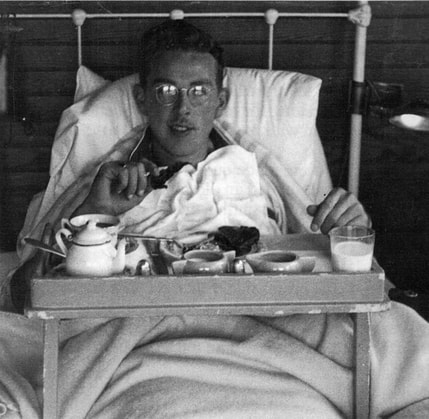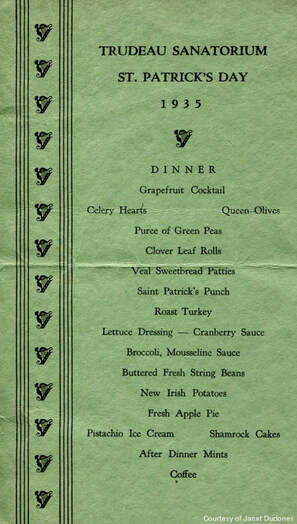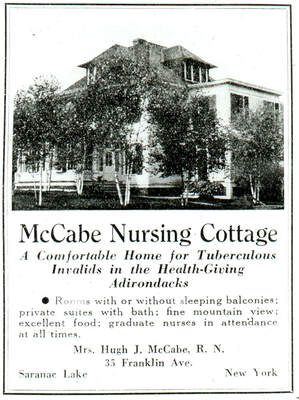|
By Kayt Gochenaur “Ample food is necessary to health.” This adage was a founding principle of the fresh air cure for tuberculosis. The fresh air cure had three tenets: fresh air, good food, and plenty of rest. Saranac Lake was famous for its clear mountain air, but we also knew a thing or two about food. In the 1800s, tuberculosis was called consumption because it consumed the body fat. Patients were often underweight, without appetite, and flushed from a fever. Hope for recovery depended on eating from a well-filled dinner plate as much as on the lauded mountain air. Early practitioners of the fresh air cure like Dr. Hermann Brehmer advocated treating TB with an abundant diet, a strong Hungarian wine, and cognac. When Dr. Edward Livingston Trudeau founded the Trudeau Sanatorium in Saranac Lake, he built his own treatment philosophy on the successes of these doctors. Different doctors and decades brought about new fads in the recommended diet for TB patients. Dr. Trudeau’s patients ate hearty food and cod-liver oil. Later, TB doctors favored dairy products for their high fat content and purported ease of digestion (my sympathy to those lactose intolerant patients). Dairy faded in popularity towards the end of the curing industry. Florence Mulhern, a Trudeau Sanatorium patient in the 1950s, said that dinners were always hot and hearty and the potatoes usually mashed. Patients were expected to eat regardless of their appetite. Bill McLaughlin remembered this emphasis on food. As he stated in an oral history interview by Rhee Rickard, “My God, the first thing they did was build you up. Eggnogs with six eggs if you wanted. We all looked better than the people who came to visit us.” Preventing weight loss was so important that one TB patient had to eat a seven-ounce Hershey chocolate bar every day, ruining her love of chocolate. Dr. Lawrason Brown of Trudeau Sanatorium encouraged patients to “Eat once for themselves, once for the germs, and once to gain weight… not only must three good meals but six glasses of milk and six raw eggs be swallowed every day.” If this surprises our modern sensibilities, remember that the link between bacteria and illness was new to Western medicine, and the heroin and opium used in TB treatments was probably more dangerous than the eggs At a typical cure cottage, food preparation was a daunting task. An account from Kevin Healy describes Loretta McCabe’s daily work running a cure cottage. “[She] did all the cooking. My mother said that she dirtied every pot and utensil in the kitchen ... there was always a starch, a protein, a green vegetable, and an orange vegetable and then some sort of dessert. She paid attention to the color and every plate was made to look appetizing so that it would encourage the patients to eat.”
Contrary to Dr. Brehmer’s recommendation of wine and cognac, alcohol was forbidden at Trudeau Sanatorium. After prohibition this rule relaxed and, by the 1950s, patients at both Ray Brook and Trudeau were allowed their own alcohol. Some patients described a high prevalence of alcoholism at sanatoria, and the connection between tuberculosis and alcoholism is still being studied today. The demand for fresh food and dairy gave rise to a thriving agricultural industry in Saranac Lake. With the refrigeration and shipping constraints of the day, much of the food for area patients was locally grown. Dairies like Crystal Spring (now called Donnelly’s) met the high demand for pasteurized milk, while sanatoria like Stony Wold on Lake Kushaqua, had their own farms and claimed to be self-sufficient. Did all this food help patients? Vitamins A and D and high protein do promote healthy immune systems. Undernutrition is considered a risk factor for TB, and patients fighting off infection would have had a better chance at recovery if they maintained a healthy weight. As to the efficacy of Hungarian wine, raw eggs, cod liver oil, or chocolate--well, you’ll have to ask your doctor about that!
3 Comments
8/30/2021 07:36:53 pm
Thank you for sharing this very informative content I read a lot of importance's to live longer by taking self care by drinking food supplements daily. I also recommend Haarlem Oil made from France. It can help to boost your immune system to fight against viruses.
Reply
Mato Ray
3/28/2022 08:50:26 am
Reply
6/7/2022 10:40:30 pm
i will happy to your work You have share a kind information with me <a href="https://www.knowledge-wisdom.com/what-vitamins-are-good-for-losing-belly-fat/">What Vitamins Are Good For Losing Belly Fat</a>
Reply
Your comment will be posted after it is approved.
Leave a Reply. |
About us
Stay up to date on all the news and happenings from Historic Saranac Lake at the Saranac Laboratory Museum! Archives
August 2022
Categories
All
|
Historic Saranac Lake at the Saranac Laboratory Museum
89 Church Street, Suite 2, Saranac Lake, New York 12983
(518) 891-4606 - [email protected]
89 Church Street, Suite 2, Saranac Lake, New York 12983
(518) 891-4606 - [email protected]

Historic Saranac Lake is funded in part by the New York State Council on the Arts with the support of the Office of the Governor and the New York State Legislature,
and an Essex County Arts Council Cultural Assistance Program Grant supported by the Essex County Board of Supervisors.
and an Essex County Arts Council Cultural Assistance Program Grant supported by the Essex County Board of Supervisors.
© 2023 Historic Saranac Lake. All Rights Reserved. Historic photographs from Historic Saranac Lake Collection, unless otherwise noted. Copy and reuse restrictions apply.



 RSS Feed
RSS Feed